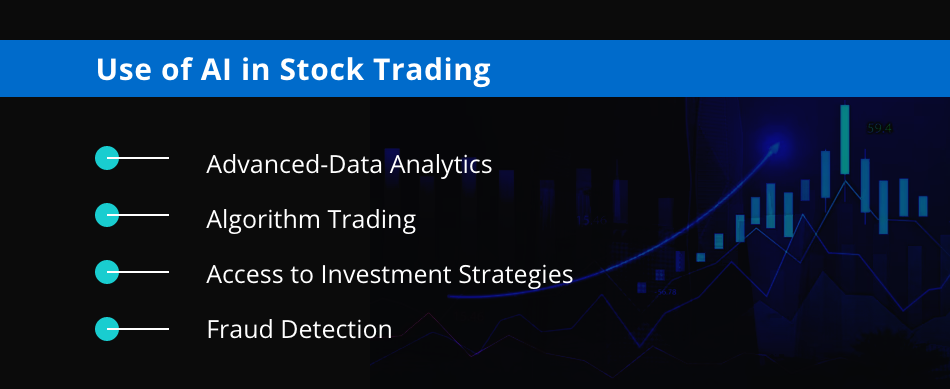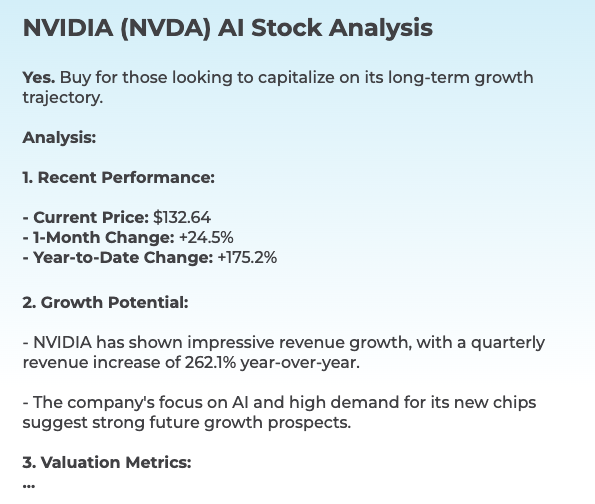20 Free Ideas To Picking AI Stock Predictions Analysis Websites
20 Free Ideas To Picking AI Stock Predictions Analysis Websites
Blog Article
Top 10 Tips On Assessing The Ai And Machine Learning Models Of Ai Stock Predicting/Analyzing Trading Platforms
The AI and machine (ML) model utilized by stock trading platforms and prediction platforms need to be evaluated to ensure that the data they offer are reliable and reliable. They must also be relevant and applicable. Incorrectly designed models or those that oversell themselves can result in faulty forecasts as well as financial loss. Here are the 10 best strategies for evaluating AI/ML models that are available on these platforms.
1. Learn the purpose of the model and its approach
Clarity of purpose: Determine whether this model is designed to be used for trading on the short or long term, investment or risk analysis, sentiment analysis and more.
Algorithm transparency: See if the platform discloses types of algorithm used (e.g. Regression, Decision Trees, Neural Networks, Reinforcement Learning).
Customization: See whether the model could be customized to suit your particular trading strategy or your risk tolerance.
2. Measure model performance metrics
Accuracy: Check the model's prediction accuracy. Don't base your decisions solely on this measure. It can be misleading on financial markets.
Accuracy and recall: Check whether the model is able to discern true positives, e.g. correctly predicted price fluctuations.
Risk-adjusted results: Determine the impact of model predictions on profitable trading in the face of accounting risks (e.g. Sharpe, Sortino, etc.).
3. Check your model by backtesting it
Performance historical: Test the model with previous data and see how it would perform in previous market conditions.
Testing using data that isn't the sample is essential to avoid overfitting.
Scenario-based analysis: This entails testing the accuracy of the model in various market conditions.
4. Make sure you check for overfitting
Overfitting: Be aware of models that are able to perform well using training data but not so well with unseen data.
Regularization methods: Ensure whether the platform is not overfit when using regularization methods such as L1/L2 and dropout.
Cross-validation is essential and the platform must use cross-validation when assessing the generalizability of the model.
5. Assess Feature Engineering
Important features: Make sure that the model is based on meaningful attributes (e.g. price, volume and technical indicators).
Select features that you like: Choose only those features which are statistically significant. Do not select redundant or irrelevant information.
Updates to features that are dynamic: Determine whether the model will be able to adjust to changes in market conditions or new features over time.
6. Evaluate Model Explainability
Interpretability: Ensure that the model provides clear explanations for the model's predictions (e.g., SHAP values, feature importance).
Black-box Models: Watch out when you see platforms that use complicated models that do not have explanation tools (e.g. Deep Neural Networks).
User-friendly insight: Determine whether the platform is able to provide actionable insight for traders in a way that they understand.
7. Examine the flexibility of your model
Market changes: Determine whether the model is able to adapt to new market conditions, for example economic shifts and black swans.
Continuous learning: Ensure that the platform updates the model by adding new data in order to improve performance.
Feedback loops: Ensure the platform includes feedback from users as well as real-world results to help refine the model.
8. Check for Bias or Fairness
Data bias: Ensure that the information provided within the program of training is accurate and does not show bias (e.g., a bias toward certain industries or times of time).
Model bias - Determine whether your platform is actively monitoring the biases and reduces them within the model predictions.
Fairness - Make sure that the model is not biased in favor of or against particular sector or stocks.
9. Evaluate the computational efficiency
Speed: Check if your model is able to produce predictions in real-time or with minimal delay particularly when it comes to high-frequency trading.
Scalability Test the platform's capacity to handle large sets of data and multiple users without performance loss.
Resource usage: Verify that the model has been optimized for the use of computational resources efficiently (e.g. use of GPU/TPU).
Review Transparency & Accountability
Model documentation: Ensure the platform provides comprehensive documentation about the model's design and its the training process.
Third-party validation: Determine whether the model was independently verified or audited by an outside person.
Verify whether the system is outfitted with mechanisms to detect model errors or failures.
Bonus Tips:
Case studies and user reviews: Research user feedback and case studies to evaluate the performance of the model in real-life situations.
Trial period: Try the software for free to determine how accurate it is and how simple it is utilize.
Customer support - Make sure that the platform you choose to use is able to provide a robust support service in order to resolve technical or model related issues.
If you follow these guidelines, you can assess the AI/ML models on platforms for stock prediction and make sure that they are reliable, transparent, and aligned with your goals in trading. Take a look at the most popular her comment is here on stock ai for blog examples including ai stocks, incite, ai stocks, options ai, ai stock trading app, incite, chart ai trading assistant, ai for investment, ai investing platform, investment ai and more.
Top 10 Tips On Assessing The Social And Community Features Of Ai Platform For Predicting And Analyzing Stocks
It is essential to comprehend how users interact, share knowledge and gain insights from each other by analyzing the social and community features of AI-driven prediction platforms and trading platforms. These features can help improve the user experience as well as provide valuable assistance. Here are 10 top strategies for evaluating social and community features available on these platforms.
1. Active User Communities
Check to see whether there's an active user community that engages regularly in discussions and provides information.
Why? A lively user community represents a lively community where users can share knowledge and grow together.
2. Discussion Forums, Boards, and Discussion Forums
Examine the activity and quality of message boards or discussion forums.
Why? Forums let users post questions, debate strategies and market trends.
3. Social Media Integration
Tips - Make sure that the platform can be integrated with social media sites (e.g. Twitter and LinkedIn) to post information and updates.
Why: Social media integration can boost engagement and give actual-time market information.
4. User-Generated content
Search for features that permit users to create, share, and modify content.
Why: User-generated content creates an environment of collaboration and offers diverse perspectives.
5. Expert Contributions
TIP: Check if the platform includes contributions from experts in the field, like market analysts and AI specialists.
Expert opinions add depth and credibility to community discussions.
6. Chat in Real-Time, Chat in Real-Time and Chat in Real Time
TIP: Find out if users can communicate with each other instantly by using chat or real-time messaging.
The reason: Real-time interaction allows rapid data exchange and collaboration.
7. Community Moderation Support
TIP: Examine the degree of moderation and support offered by the community.
The reason: Effective moderating makes sure that a positive and respectful atmosphere is maintained, while customer support helps resolve issues quickly.
8. Webinars and Events
Tip Check whether the platform hosts live Q&As with experts or hosts webinars.
Why: These events provide the opportunity to gain knowledge and provide direct interaction with industry experts.
9. User Reviews
Tips: Be on the lookout for features which permit users to provide feedback or opinions about the platform and its features.
The reason: Feedback from users is used to determine strengths and areas for improvement in the community ecosystem.
10. Gamification and Rewards
Tip: Determine if the platform includes gaming elements, like badges or leaderboards.
Gamification is a highly effective method that helps users engage more with their community and the platform.
Tips for Privacy and Security
Make sure that security and privacy features that are used for social and community functions are strong enough to guard data and user interactions.
You can assess these features to decide if the AI trading and stock prediction platform has the community you need and engages you in trading. Follow the best right here about invest ai for site info including best ai penny stocks, ai stock investing, ai options, ai for trading stocks, ai investment tools, ai trading tool, ai copyright signals, ai stock trader, best ai stocks to buy now, best ai trading platform and more.